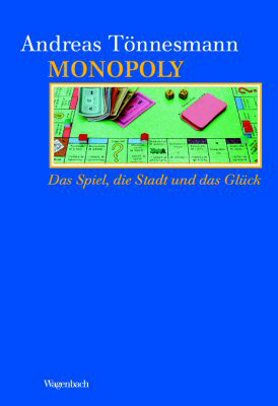Andreas Tönnesmann
Monopoly. Das Spiel, die Stadt und das Glück
[Monopoly. The Game, the City and the Luck]
Andreas Tönnesmann
Monopoly. Das Spiel, die Stadt und das Glück
[Monopoly. The Game, the City and the Luck]
Sample translations
Review
All successful games share one common trait: that their basic concept can be summed up in one sentence. In football, the winning team is the one that scores the most goals. In chess, the ultimate aim is to checkmate your opponent’s king. And with the best-selling party game of all time, it’s this: To stay solvent as long as you possibly can whilst forcing your opponents into bankruptcy.
There are probably very few people who have never moved a play figure along Monopoly’s streets. Who haven’t trembled in front of a hotel on the Boardwalk and pocketed their salary with relief as soon as they made it past ‘Go’. Since being patented on New Year’s Eve in 1935, Monopoly has sold around 10,000 copies a day. But where does this fascination for a board game that revolves entirely around land speculation come from?
Bonn art historian Andreas Tönnesmann searches for the answers in his book ‘Monopoly: The Game, the City and the Luck’. With remarkable dedication, he links the game’s historical background with his own interpretation, based on architectural theory. He takes a triple jump approach – ‘idea, game, city’ – and executes it perfectly to the highest of academic standards. This isn’t just down to the illustrations, which number more than thirty, but to a combination which is quite rare in these parts: the Art and Architectural History professor writes in a way which combines academic meticulousness and depth with appealing comprehensibility and nonchalance.
As Tönnesmann explains, the player with the best chance of winning at Monopoly is the one who can most skilfully combine daring, reason and optimism. Chance plays an important role too of course, but to win you also need to behave in a way which modern psychology would describe as ‘hostile and damaging’ rivalry. The motto is: ‘One against all’. This dog-eat-dog mentality was also shared by the game’s inventor: Charles Darrow from Germantown, Pennsylvania. A heating engineer and plumber in his early forties, Darrow – like millions of other Americans – lost his job during the Great Depression.
A board game called the ‘Atlantic City Game’ became one of his hobbies, and the template for his own version, made at home with the help of a fret saw, a wax cloth and paintbrushes. Street names, ‘chance’ cards, the start and jail squares – he copied them all straight across. But instead of just seeing Darrow as an audacious plagiariser, Tönnesmann emphasises his ‘conceptual imagination’ and design talent. Even if his ‘invention’ was based on various forerunners, Darrow still gave it its catchy name and made it marketable. And so a board game developed in times of crisis became a global mass product. And its inventor very quickly became a millionaire.
Monopoly didn’t get very far in National Socialist Germany. But that made it even more popular in other parts of the world. Tönnesmann highlights the game’s seemingly unlimited potential for adaptation, an important pre-requisite for its triumphal march around the globe, a journey which started out from Philadelphia’s shopping centre ‘Wanamaker’s’. In 1942, a version called ‘Ghetto’ was even made in the Theresienstadt concentration camp, and is now on display in the Yad Vashem memorial. But Monopoly’s moment of glory came in the Cold War. Despite a strict ban on imports in places like the GDR, in the West it became the epitome of the ‘American Way of Life.
Tönnesmann makes a connection between the history of its creation and the concept of the ideal city. For the 58-year old college professor, Monopoly is without doubt a product of the modern age, and one which is inextricably linked with town-planning ideas of the modern era. To illustrate this, he touches upon classical examples of ideal cities: from the Hippodamus city plan he jumps forward to the Renaissance, to Filarete’s ‘Sforzinda’ and Thomas More’s ‘Utopia’. In this light, Monopoly seems like the ideal of a city, a ‘played utopia’. Drawing further parallels, Tönnesmann compares the game with Ebenezer Howard’s garden city and the urban concepts of the American architect Frank Lloyd Wright.
Despite being a symbol of the modern city, Monopoly lacks crucial landmarks like churches, hospitals, schools, museums or swimming pools. Nor does the board, which essentially functions as a street plan, show any signs of productive industry or trade. And, unlike real cities, you can’t leave Monopoly. Not one of the four train stations gives you the chance to; all of the railway lines end at the edge of the playing area. The ideology is clear: Liberalist economic practice dominates, the goal of which is the independence of the individual. Profiteering and a ‘deliberately excessive yield policy’ define the lives of the inhabitants of Monopoly. Over seventy-five years after it was first brought onto the market, the game still remains popular, and there are now even Monopoly world championships. For a game which represented a critical commentary of Franklin D. Roosevelt’s economic and social reform from the very start, it has lost very little of its relevance today. Because regardless of what happens on the board, the bank can never go bankrupt.

There are probably very few people who have never moved a play figure along Monopoly’s streets. Who haven’t trembled in front of a hotel on the Boardwalk and pocketed their salary with relief as soon as they made it past ‘Go’. Since being patented on New Year’s Eve in 1935, Monopoly has sold around 10,000 copies a day. But where does this fascination for a board game that revolves entirely around land speculation come from?
Bonn art historian Andreas Tönnesmann searches for the answers in his book ‘Monopoly: The Game, the City and the Luck’. With remarkable dedication, he links the game’s historical background with his own interpretation, based on architectural theory. He takes a triple jump approach – ‘idea, game, city’ – and executes it perfectly to the highest of academic standards. This isn’t just down to the illustrations, which number more than thirty, but to a combination which is quite rare in these parts: the Art and Architectural History professor writes in a way which combines academic meticulousness and depth with appealing comprehensibility and nonchalance.
As Tönnesmann explains, the player with the best chance of winning at Monopoly is the one who can most skilfully combine daring, reason and optimism. Chance plays an important role too of course, but to win you also need to behave in a way which modern psychology would describe as ‘hostile and damaging’ rivalry. The motto is: ‘One against all’. This dog-eat-dog mentality was also shared by the game’s inventor: Charles Darrow from Germantown, Pennsylvania. A heating engineer and plumber in his early forties, Darrow – like millions of other Americans – lost his job during the Great Depression.
A board game called the ‘Atlantic City Game’ became one of his hobbies, and the template for his own version, made at home with the help of a fret saw, a wax cloth and paintbrushes. Street names, ‘chance’ cards, the start and jail squares – he copied them all straight across. But instead of just seeing Darrow as an audacious plagiariser, Tönnesmann emphasises his ‘conceptual imagination’ and design talent. Even if his ‘invention’ was based on various forerunners, Darrow still gave it its catchy name and made it marketable. And so a board game developed in times of crisis became a global mass product. And its inventor very quickly became a millionaire.
Monopoly didn’t get very far in National Socialist Germany. But that made it even more popular in other parts of the world. Tönnesmann highlights the game’s seemingly unlimited potential for adaptation, an important pre-requisite for its triumphal march around the globe, a journey which started out from Philadelphia’s shopping centre ‘Wanamaker’s’. In 1942, a version called ‘Ghetto’ was even made in the Theresienstadt concentration camp, and is now on display in the Yad Vashem memorial. But Monopoly’s moment of glory came in the Cold War. Despite a strict ban on imports in places like the GDR, in the West it became the epitome of the ‘American Way of Life.
Tönnesmann makes a connection between the history of its creation and the concept of the ideal city. For the 58-year old college professor, Monopoly is without doubt a product of the modern age, and one which is inextricably linked with town-planning ideas of the modern era. To illustrate this, he touches upon classical examples of ideal cities: from the Hippodamus city plan he jumps forward to the Renaissance, to Filarete’s ‘Sforzinda’ and Thomas More’s ‘Utopia’. In this light, Monopoly seems like the ideal of a city, a ‘played utopia’. Drawing further parallels, Tönnesmann compares the game with Ebenezer Howard’s garden city and the urban concepts of the American architect Frank Lloyd Wright.
Despite being a symbol of the modern city, Monopoly lacks crucial landmarks like churches, hospitals, schools, museums or swimming pools. Nor does the board, which essentially functions as a street plan, show any signs of productive industry or trade. And, unlike real cities, you can’t leave Monopoly. Not one of the four train stations gives you the chance to; all of the railway lines end at the edge of the playing area. The ideology is clear: Liberalist economic practice dominates, the goal of which is the independence of the individual. Profiteering and a ‘deliberately excessive yield policy’ define the lives of the inhabitants of Monopoly. Over seventy-five years after it was first brought onto the market, the game still remains popular, and there are now even Monopoly world championships. For a game which represented a critical commentary of Franklin D. Roosevelt’s economic and social reform from the very start, it has lost very little of its relevance today. Because regardless of what happens on the board, the bank can never go bankrupt.
Translated by Jamie Lee Searle

By Daniel Grinsted
Daniel Grinsted is a cultural critic with a degree in Anglo-American literature. He works as a freelance arts journalist for the Frankfurter Allgemeine Zeitung, Zeit Online, Literaturen, Börsenblatt and other media.
